The industry is expanding its view of this technology’s applications, with a shift toward incorporating expandables into the primary design of the well rather than just using them as contingency systems.
Diane Langley, Technology Editor
Progress in expandable technology over the past year has included advances like nested systems (one expandable liner installed into another), a testing facility dedicated to expandable connector performance, and a new centralizer for close-tolerance applications. Expandable applications continue to move into increasingly extreme environments, and service providers see innovative new applications—such as plugging and abandonment of offshore wells to replace expensive and time-consuming conventional methods—in the offing for this versatile technology.
What is driving expandable technology development in the present industry environment? Primarily it is the need to enhance mechanical, pressure and temperature capabilities while continuing to increase reliability. Other drivers are the drilling of more complex wells and the need for more effective exploitation of mature fields. Solid expandable products are not panaceas for solving all trouble-zone challenges in complex wells. Historically, solid expandables have been a last-ditch effort when an operator has tried everything else. Complementary technologies for mitigating trouble zones with solid expandables include managed pressure drilling and drilling with casing or liner.
While a mono-diameter wellbore is still widely considered a “holy grail” of expandable technology application, long mono-diameter well segments have already been deployed using expandable tubulars. Meanwhile, a school of thought exists that casts doubt on whether the monobore well is a “cure all” solution; in many situations, it may not offer significant advantages over more conventional solutions and may actually be a disadvantage.
The industry consensus is that development of expandables has followed take-up of the technology. The expandable technology evolution is on one level mature, in that several companies know how to expand long lengths of tubulars reliably and have extensive experience doing so. It is, however, a very versatile technology, and there are many aspects of it that are not well understood and that are continuously being improved.
Global uptake has hindered overall speed of development for solid expandables. As with the commercialization of most new products within the oil and gas industry, the more out-of-the-box technologies, such as solid expandables, sometimes take decades to realize full product utilization. Game-changing technology is typically harder to implement due to the need to shift engrained paradigms. Another contributing factor to the slow uptake of this technology is the fact that high-quality yet inexpensive expandable tubulars and connections are not widely available. This is strictly a commercialization issue due to the relatively low volume of product required by operators compared with conventional oil country tubular goods (OCTG). The global market for expandable tubulars is currently very small (less than 1% of that for conventional OCTG), which can create a less-than-impressive business case for the growth of providers.
WHERE WE’VE BEEN
The use of expandable tubes as part of well construction existed prior to the 1960s, and solid expandable tubulars have been installed in both open- and cased-hole wellbores since November 1999 in a variety of environments in wells on land, offshore and in deep water to solve a range of drilling and completion challenges. Baker Hughes opened the market in 1994 with the ZXP liner packer system, followed by Weatherford in 1998 with its expandable sand screen technology for sand control. Enventure entered in 1999 with its Solid Expandable Tubular (SET) system and others followed quickly, including READ Well Services with its Hydraulically Expandable Tubular System (HETS) development in 2000. Halliburton entered the expandable market with its PoroFlex sand screen in 2001. TIW introduced the XPatch expandable casing patch in 2003.
In the majority of early installations, solid expandables were deployed as a contingency to save a well when conventional technology failed. They are now used in conventional applications for remediation, rejuvenation and refurbishment of mature field assets; in unconventional gas completions in combination with perforating and fracturing techniques; as a large production conduit for deep and ultradeep wells in conventional wellbore casing programs; as a large production conduit to slim the wellbore and still attain adequate hole size at total depth; and in production applications to address isolation challenges in cased-hole and openhole scenarios.
Below are the latest developments in expandable technology and applications by service provider.
BAKER HUGHES
Baker Hughes continues to deploy such legacy systems as expandable casing patches for 9⅝-in., 7-in. and 5½-in. casing sizes (primarily used in water shutoff applications and corrosion issues) and expandable sand control screens for varied openhole sizes (pre-expansion screen sizes are 4¾, 6⅞ and 7⅝ in.). The company says its casing patches offer one of the largest post-expansion throughput IDs in the industry and require no drillout. Recent requests for expandable products that can be used in geothermal applications are being evaluated for product modifications and upgrades.
Currently being launched for commercial application is the linEXX monobore expandable liner extension system. After a first commercial trial in 2006, the second commercial application was successfully deployed in Egypt in May 2010, Fig. 1. This technology provides the industry with a method to extend an existing (9⅝-in. OD) casing string by expanding a liner below it, with no loss to the casing ID above and with provision for drillout of the extended liner with an 8½-in. bit. Though both applications were successful, lessons were learned and new products developed between these two installations.
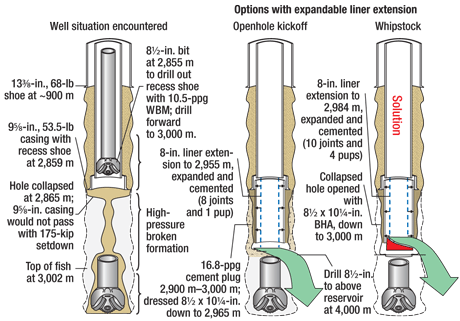 |
|
Fig. 1. Well profile with expandable solution.
|
|
After the 2006 installation, Baker Hughes developed its FORMpac expandable packers to work with the system to provide a monobore extension that would require no cement and thus no drillout from the shoe track of the expanded liner. Post-expansion, the OD of the solid body wrapped with reactive rubber is sized to interfere with the wellbore. The reactive rubber provides for an additional seal in irregular or slightly larger wellbores.
In cement applications, the need for close-tolerance expandable centralizers has long been recognized by the industry. Baker Hughes worked with Antelope Oil Tool & Manufacturing Co. in Mineral Wells, Texas, to provide the first such product. The first application of this product in the field was realized in Egypt this year.
The slip-on design bow springs are AISI (American Iron and Steel Institute) 4130 heat treated and have a creased profile, which provides the necessary holding forces in the collapsed mode. The centralizer is run in hole in collapsed mode, allowing passage through very tight restrictions and requiring no running and starting force. Once at depth, the close-tolerance expandable centralizers are deployed by pipe expansion. The centralizers are sizable for a broad range of expandable tubulars.
In the Egypt application, the centralizers performed beyond expectations. Even after running in hole and then pulling out of hole—due to the hole caving in and preventing the liner reaching depth—the centralizers were not damaged, held their position and were ready for deployment again.
An additional close-tolerance centralizer to provide wellbore standoff while running in hole is also under development. One size of this product was developed by Antelope Oil Tool and fully tested and evaluated by Baker Hughes, but is awaiting field trial evaluation.
ENVENTURE
Enventure Global Technology had a record-setting 2009. Not only did the company install the longest solid expandable liner in history at 6,935 ft, it also developed and installed three newly designed expandable systems. In addition, continued planned-in adoption of expandable technology offered promising new wellbore designs.
The record-setting installation of a nearly 7,000-ft openhole liner also marked the first time an expandable liner using swellable elastomers was installed in the Gulf of Mexico. The operator planned the ultra-deep well in shallow GOM waters to maximize the use of existing infrastructure. As part of the wellbore design, a 7⅝ x 9⅝-in. solid expandable system extended the 9⅝-in. shoe, providing substantial savings and facilitating the discovery of an approximately 150-ft-deep gas pay zone. The use of swellable elastomers on the shoe of the expandable liner ensured a successful leakoff test without the need for a remedial shoe squeeze—saving about
$1 million, Fig. 2.
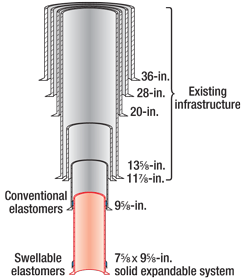 |
|
Fig. 2. Swellable elastomers on the shoe of the expandable liner ensured leakoff test success and eliminated the need for a remedial shoe squeeze.
|
|
An operator in North Dakota’s Bakken Shale was fracing three wells when a frac sleeve failure threatened each well’s 10-stage completion. Any repair option required a 3.26-in. drift diameter so that multiple frac balls (ranging in sizes from 0.5 to 3.25 in.) could activate the remaining zones. Additionally, a high-performance solution was needed to withstand downhole conditions of 7,500 psi and 325°F—well beyond the capacity of a standard expandable cased-hole liner (CHL). At the request of the operator, Enventure engineered and tested a new 3½ x 4½-in., single-joint system that exceeded that pressure rating, with capacity to withstand 10,000 psi at 325°F. Three liners were installed (one in each of the three wells), which enabled the operator to continue on target with the completion program.
Another high-performance system was also engineered and installed in 2009, this time for an offshore application. The 11¾ x 13⅜-in. high-performance system was originally designed for the complex and demanding environments offshore North Africa. However, the design found its first use for a major Gulf of Mexico operator sidetracking from an existing wellbore. Excessive wear at the kickoff point in the 13⅜-in. casing was compromising casing integrity. Enventure provided the new high-performance liner to cover damage and provide additional protection. As a result, the operator was able to successfully re-establish wellbore integrity and drill to new reserves.
Casing integrity is one of the primary applications for solid expandables in remediation projects. In Canada’s oil sands plays, there are few options for repairing damage—and none that maintain internal diameter like a solid expandable liner. The extreme temperatures and harsh operating environments found in these plays had been off limits to expandables until just last year. Enventure, in partnership with various operators, established operating parameters for an expandable liner that could repair casing damage in oil sands applications. The current solution is a single-joint system rated to 518°F at 1,000 psi. The first installation was in Canada’s Saskatchewan province. A 9⅝ x 11¾-in. high-temperature CHL expandable system was run to repair a damaged section of 11¾-in. casing. This was a substantial gain for the operator as it enabled the continued use of the well without compromising the pad, which comprised a set of 32 wells.
Designing solid expandables into the well architecture leverages existing wells as starting points. These programs use wells that have existing casing strings in place and, as a result, are size constrained when re-entered. These re-entry programs can maximize capitalized assets, saving time and money by enabling use of existing infrastructure to potentially add to the reserve base or new reserves.
Future applications of solid expandables to slim down the wellbore architecture are also getting notice. For example, use of expandables to slim down the wellbore architecture resulted in 20% well-cost savings in a recent onshore project, and is now being evaluated for offshore drilling, where larger 16 x 20-in. expandable systems can be installed to increase the rate of penetration and reduce overall risk. Multiple expandable liners can now also be installed inside each other as a “nested system” to create even further value, Fig. 3.
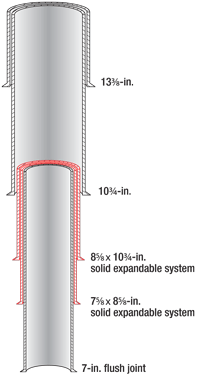 |
|
Fig. 3. Multiple expandable liners installed inside each other as a “nested system.”
|
|
Similar savings are found in remediation projects. A solid expandable liner provides a robust and reliable repair while maximizing ID. This mitigates the risk often associated with other solutions such as cement squeezes. Additionally, it provides the largest wellbore possible for maximized injection and production rates. New expandable systems are being developed with increased collapse and yield ratings to meet more challenging environments of production and completion programs.
HALLIBURTON
Halliburton’s expandable technology focus centers on the VersaFlex expandable liner hanger (ELH) product line, particularly applicable in critical well operations, Fig. 4. ELH has moved from a niche technology to a mainstream solution that regularly competes with conventional liner technology. To date, the company has run in excess of 2,100 ELH jobs in 32 countries, and it expects the growth trend to continue. The ELH technology, offered in three metallurgies (expandable carbon steel alloy, super-13 chrome and high-nickel Alloy 825), carries a gas-tight production packer ISO 14310 V0 rating.
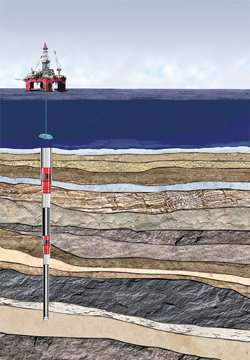 |
|
Fig. 4. Expandable large-bore liner hangers provide an alternative to mudline suspension systems in subsea and extended reach drilling markets.
|
|
The VersaFlex liner hanger holds the record for the deepest liner set in the Gulf of Mexico, with a total vertical depth greater than 33,500 ft. The longest liner deployed to date measured over 14,000 ft and was set thousands of feet into a horizontal extended reach wellbore. Halliburton has also seen success with a drill-in application, having drilled over a dozen liners to depth, with the longest rotary-drilled interval at just under 1,000 ft with a 7-in. liner and drillable casing drill shoe.
The company continues to focus on reliability in critical wells with the ongoing development of a line of high-temperature, high-pressure expandable liner hangers. The company is filling out its Big Bore line of systems aimed at large liners from 13⅝ to 18⅝ in., which offer operators an alternative to mudline suspension systems in subsea and extended reach drilling markets. Initial 13⅝- and 16-in. systems have seen success; a 22 x 18-in. system is being developed and will soon be available commercially. Finally, Halliburton’s expandable technology engineers are increasing the company’s drill-in liner system offerings, working with Halliburton Drilling to provide a rotary steerable system due in 2011.
READ WELL SERVICES
READ Well Services offers a line of hydraulically expandable products for addressing well barrier issues. The HETS external casing patch (EP) provides a life-of-well gas-tight solution for reconnecting casing strings. It is currently available in 9⅝-in., 9⅞-in., 13⅜-in., 13⅝-in. and 14-in. sizes. The EP is qualified in accordance with ISO 13679 and (in some sizes) ISO 14310. A 7-in. design is in the process of being qualified.
Seen as a unique solution for annular gas, the HETS casing packer (CP) is an expandable annular metal packer that provides a gas-tight seal (qualified to ISO14310 V0) and a high bidirectional axial load-bearing capacity. The metal barrier can withstand high axial loads induced by temperature variations. This year, READ Well Services added a 9⅝ x 13⅜-in. CP to its casing string offerings, which already include 7¾ x 10¾-in., 7⅝ x 9⅝-in. and 9⅝ x 11¾-in.
The company also developed the CP096 expandable CP for 9⅝-in. casing inside 13⅜-in. or 13⅝-in. casing, specifically for a client that had poor success with alternative mid-string packers. The CP096 is more than 1 in. smaller in OD than alternative packers, resulting in much lower equivalent circulating density of drilling fluid. In this application, the CP provided a 3,200-psi gas-tight annular seal.
READ Well Services’ Zonal Isolation Barrier (ZIB), a hydraulically expanded metal sleeve that provides an openhole annular barrier to flow, has seen extensive development this year and is currently being tested for very high axial loading (in excess of 300,000 lb), Fig. 5. This is in response to client demands for higher load-bearing capacity that will resist axial movement and, thus, preserve the seal against the formation. Qualification work is ongoing with several major operators in and outside the North Sea region.
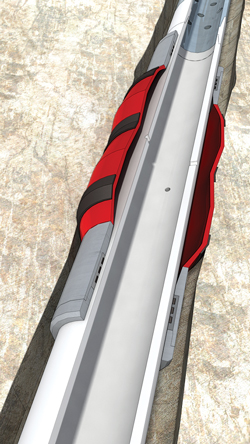 |
|
Fig. 5. READ Well Services’ ZIB.
|
|
The ZIB is available for 6-in., 6½-in. and 8½-in. open hole. It can be used to support cementing operations and ensure that the cement stays in the correct place, as a contingency in case the cement job is poor, and as an alternative to cement or other openhole packers when cement is not desired or possible (e.g., when running screens or in extended reach directional wells). According to the manufacturer, the ZIB has exceptional strength and longevity due to its steel construction. The company also says the ZIB is particularly effective during stimulation, fracturing or injection because it is an “active packer”—i.e., supported by wellbore pressure—as opposed to other expandable packers that the company classifies as “passive” because they are supported by their mechanical designs and not by wellbore conditions.
READ’s internal patch (IP), tested in accordance with ISO14310, is a hydraulically expanded sleeve that is carried into the well with the expansion tool and expanded over zones of concern in a well (e.g., leaking tubing or liner, perforations that require sealing off, corroded or worn tubulars that require reinforcing). The patch enables tubular repairs and isolations through restrictions and previously patched sections and minimizes well restriction (reduced only by the wall thickness of the patch). Available for 4½-in., 5½-in. and 7-in. tubulars, this expandable patch system can be conveyed on drill pipe, coiled tubing or wireline (only available for smaller sizes). The introduction of the wireline-conveyed IP for 4½-in. and 5½-in. tubulars took place this past year.
A joint industry partnership was begun three years ago with five industry partners (BP, Chevron, Maersk, Statoil and Total) with the aim to develop and commercialize a wireline-deployed, expandable internal patch for 4½-in. and 5½-in. tubular. The prototype system was successfully deployed in a land test well earlier this year. The system is now awaiting a field test. Designs for 9⅝-in., 9⅞-in. and 10¾-in. casings are currently in progress.
WEATHERFORD
Weatherford International is collaborating with major operators to bring to market a multiple-monobore shoe extension system (i.e., a monobore well) below 13⅜-in. or 13⅝-in. casing (11¾ x 13⅜-in. or 11¾ x 13⅝-in. monobore). This size system will provide the end user with several extensions of a larger tubular expandable system that enables extending the 13⅜-in. or 13⅝-in. casing string several times, in turn allowing use of high-collapse conventional tubulars lower in the operator’s wells.
The company already provides the industry with a single-monobore openhole liner (shoe extension) below the 13⅜- or 13⅝-in. conventional casing string. Its effective application is providing an extension of the casing shoe without a loss of a hole size, facilitating a 12¼-in. drillout. Well plan collaboration with multiple global operators has found that simply extending the 13⅜-in. or 13⅝-in. conventional casing string a single time without the loss of hole size enables most wells to be cost-effectively drilled, achieving their perspective TDs with an optimum completion.
This type of collaborative well planning over the past several years has revealed that some of the most complex wells can be drilled (lowering their risk while obtaining their objectives) by simply being able to extend their 13⅜-in. or 13⅝-in. conventional string only twice without the loss of hole size. Until solid expandable tubulars are capable of providing the industry with post-expanded products with properties that rival conventional tubulars, the “true monobore well” will remain unrealized.
While the numbers have been run on the capability of the true solid expandable monobore well to provide significant reduction in well construction cost, this ideal must be applied to the real needs of the end user. The application of single monobore systems to extend subsequent casing shoes (Fig. 6) would provide even the most complex wells enough contingencies to significantly slim the wellbore and/or facilitate reaching TD with the most effective size completion. The latter would be more applicable to well needs and more realistic and achievable in a much shorter term.
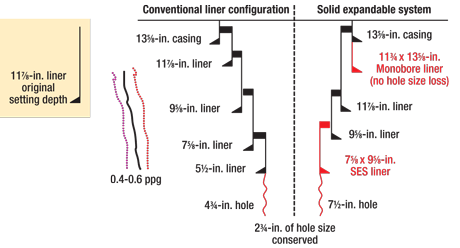 |
|
Fig. 6. Application of single-monobore systems to extend large-diameter casing.
|
|
A major Middle Eastern oil company has been using Weatherford’s expandable openhole liners to rework mature wells for maximum reservoir contact. Multiple fields’ recoverable reserves have been significantly increased, enabled with solid expandable liners horizontally extending the wells’ 7-in. casing and providing larger-ID shoe extensions. These expandable liners are being used as production liners with as many as four openhole laterals drilled with larger BHAs, facilitating increased reservoir exposure and significantly larger reserve recovery.
In terms of new applications, the combination of solid expandable liners with expandable sand screens (ESS) has already demonstrated significant value for optimizing completions in difficult fines-producing zones. Solid expandables eliminate running, cementing and perforation of completion liners by providing effective zonal isolation in open hole.
Affixing hybrid swelling elements on solid expandable liners can provide zonal isolation when the casing is expanded against competent formations. These swelling elastomers can replace or be run in conjunction with conventional elastomers and have proven very effective to provide zonal isolation and eliminate the need for cement in particular applications.
In order to simulate downhole conditions as solid expandable systems are expanded, Weatherford recently opened an OTCG research lab that enables testing of both expandable tubulars and connectors in a downhole environment where expandable systems are required to perform for a variety of in situ stresses, such as variable compressional and tensional loading during expansion as well as bending (downhole dogleg severity simulation) and “fixed-fixed” conditions during bottom-up expansion. Additionally, the designing, development, testing and qualification of metal-to-metal gas- tight connectors is being conducted.
Weatherford is in the process of globally commercializing the 11¾ x 13⅜-in. MetalSkin openhole liner system. Field trials are ongoing for the 8½-in. monobore openhole clad liner and the solid expandable liner hanger in a variety of sizes.
FUTURE VISION
According to one expandable supplier, the near future is satisfactory for this technology, whereas the distant future is bright. It takes time to build a track record, and few oil companies want to be “first users.” However, once new products and applications are widely demonstrated and available, they offer advantages that will undoubtedly increase expandable technology’s market share. 
|








